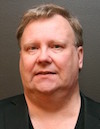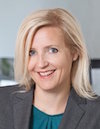![]() 20 minute read
20 minute read
Foresight gains new turns and respect. When knowledge weighs more than gold, foreseeing the future development uncovers the potential of the world development. What most of the foresight experts have in common? The vision of better, sustainable future. In the start of their careers, Jody Turner, Riikka Hackselius-Fonsén, and Jari Kaivo-Oja have not been in the foresight itself. Jody gained the feeling of trends from the design perspective, Riikka started out from the fashion direction, and Jari entered the foresight with economic and financial background. Interest in the field came when they saw the need and ways to impact the sustainable global future development. Having different background and paths, all three globally respectful professionals are experts in the foresight and future studies, who will present the meaning and heart of foresight from three different perspectives.
[nbsp]
 Jody Turner is a market insight strategist, design and global trend expert identifying influences driving people to passionately engage. For 15+ years Turner has worked with premier companies in building strategic brand and market success. Turner travels/presents with Trend Watching London and most recently with Colour House, Scandinavia. Published in Fast Company, and currently with Shareable, GOOD Magazine and Stanford Social Innovation Review.
Jody Turner is a market insight strategist, design and global trend expert identifying influences driving people to passionately engage. For 15+ years Turner has worked with premier companies in building strategic brand and market success. Turner travels/presents with Trend Watching London and most recently with Colour House, Scandinavia. Published in Fast Company, and currently with Shareable, GOOD Magazine and Stanford Social Innovation Review.
[nbsp]
 Jari Kaivo-Oja, Adjunct Professor, Research Director, is an expert working in the fields of foresight, planning sciences and innovation research. His special fields are foresight methodologies in sustainability analyses, in international energy economics and general societal development. His field and expertise spreads all around the globe from the foresight processes in Europa, The Middle East Foresight to the projects in Asia.
Jari Kaivo-Oja, Adjunct Professor, Research Director, is an expert working in the fields of foresight, planning sciences and innovation research. His special fields are foresight methodologies in sustainability analyses, in international energy economics and general societal development. His field and expertise spreads all around the globe from the foresight processes in Europa, The Middle East Foresight to the projects in Asia.
[nbsp]

Riikka Hackselius-Fonsén is an owner and founder of the Brand Agency Punda and the Focusingfuture.com. She is a customer oriented developer, pragmatic and analytic, knowledge-intensive visionary. With the 20 years experience and more than 400 developed strategy processes, Riikka has published two books about foresight strategy, consumer values and market development, Visio 2025 – Me teemme sen in 2010 and Sokaisevat Trendit in 2012.
[nbsp]
Jody Turner:
Today, the biggest trends happen to be global awareness through mass media, and the importance of local application in order to build traction. Today we have to behave with the intelligence of a global company, who has resources to apply to research and behave with global consumer intelligence. And yet, we must act like a local company, by serving the people who are buying this product or service in their local, emotional language. This is a shift within trend research, where we talk about what the human trends along with the business trends and how these two can converge to serve impending world conditions and concerns impacting everyone today. This is vital for our world.
With this we are now highly aware and engaged with everyone talking, sharing, doing and contributing to the design, retail and manufacturing directions we are heading in through global social media.
The best way we can sum it up is that trend researchers have become trend partners in strategy with companies and the people they serve.
Jari Kaivo-Oja:
The foresight is very important, especially for Finland. Finland is a small open economy, and we must scan the environment and market segments. We are not the major players like the United States or China, or Russia. We must scan the market environment, be aware of what is going on in the world, understand where we have opportunities, become a niche player in some target fields. We cannot change Chinese or US market trends, we can just be a reliable partner, that’s my opinion.
Foresight is not something new for Finnish government. We have strong futures community in the parliament of Finland: Committee of Futures. We have also strong regional foresight networks. They are organizing all kind of futures studies and activities. There is a difference between foresight and traditional future studies. Foresight is more pragmatic, focused on strategic practice and action when future studies are more strategic and visionary. Foresight activity typically combines the use of methods, network analyses and decision models. If one of these three foresight pillars is missing the “foresight business” do not function optimally.
Nevertheless, foresight should become more flexible. But the context is different in every case. In the corporate context, you have more time to use foresight. Typically, small business doesn’t have that much time to use the foresight. Small enterprises are very practical and have a lean approach. Lean approach tools are one of the challenges for foresight. How to know that you are on the right path with foresight? Meeting FARAOUT criteria (Future Orientation, Accuracy, Resource efficiency, Objectivity, Usefulness and Timeliness) is very important. Once all of the FARAOT requirements are met – you are on the right track of foresight.
Riikka Hackselius-Fonsén:
Markets will always run to the direction where they are concentrated. All product and service models have their lifecycle. And we have to understand that they will not last forever; there will always be new players trying to get your piece of the pie. Without wide outlook to the future opportunities and markets’ development, companies, and society as a whole, will run dry to their old habits. Only a few companies’ management have a capability to see and build up winning strategy without market insight data and foresight oriented processes produced by professionals. Foresight services give a professional way to the executives to find, to manage and pressure test their future plans.
[nbsp]
Jody Turner:
Recently I interviewed someone at IDEO in San Francisco, someone I have worked with before, and we spoke on how IDEO has influenced design thinking to reach out across industries, and how it is now available at large in the world of business.
Design thinking is how to ignite ideas and innovations, and how to work with others in this ignition. IDEO has launched IDEO U online courses with Stanford school (http://www.ideou.com/) to support people further in innovation processes that includes design. This is the research strategy segment. The strategy focus today is on how we implement the innovation foresight into the hands of the end user intelligently. My associate talks about educating the higher levels in companies, shifting the culture to support the innovation process from beginning to end. This may require small consulting studios work hand in hand alongside the larger companies, in implementing ideas their design thinking processes brought about. Innovation to the street.
Jari Kaivo-Oja:
In a way, the visionary thinking is a strategy planning. Of course, the foresight should be used in short-run operations. Then you must use more quantitative or predictive tools. However, if you go more than 1 or 4 years ahead, then strategic and visionary strategic thinking (more than 4 years) are more used. In the field of the corporate foresight, it is very difficult to find a company, who is not using the foresight tool. It is one big argument in favor of foresight. In Fortune list, of Top 500 companies, almost all of them are practicing foresight in some form. And it is fairly not possible to be one in the Fortune list company without future studies or foresight. Members of the list are using all kind of trend analysis, and scenario processes, analyzing mixed signals, risk analyses, etc. René Rohrbeck’s book “Corporate Foresight” explains well the motivation of the corporations to use the foresight and its value. Foresight is not just a hobby or nice game – it is a serious investment in business intelligence and dynamic competences. Foresight includes all kinds of monitoring activities, analyses and finally in-depth analyses for strategy development. Often foresight activities are linked to the analyses of market potential, new technology and organizational competences, innovation management and corporate strategy in general. It is not easy to understand, for example innovation ecosystems, without foresight.
Riikka Hackselius-Fonsén:
In many cases, strategy planning is understood as a synonym to the plans of daily actions, but without a clear[nbsp]perception of the long term effects. When the company understands what kind of trends will take a role in the markets during next ten or fifteen years, it will have the knowledge and time to build up an independent vision and set of actions. Foresight information will double the length of strategy period from three-five up to ten-fifteen years. It changes the loop of management and business development actions. Moreover, the long-term foresight-based strategy gives a possibility to lead and change market development instead of just following it. It is a foresight awareness that makes a difference between strategy and tactic plan.
[nbsp]

Jody Turner:
Now the next big trend in innovation and manufacturing. And the top example of this is Nike and how they have through a variety of different programs finally come to the place of reuse of scraps from the floor. This has turned into an incredible process for Nike and an incredible shoe, that is strong, eco and is the best seller all at the same time. That is The Nike Free Trainer.
This is an example of how manufacturing has influenced the direction of product-making today. The end user wants to know where did it come from, how is it made, how engaged is it in the culture of making and building, what is it doing to me now, how is it working for me, and ultimately where is it going to when I am done with it, how are we then recycling or upcycling this?
These are phenomenal marketing stories that are also stories of how to calm the end user who is worried about current conditions of the world. I have listed a check-list of what the end user would want today. So if to address the check-list of what end-user would want, really look into your manufacturing.
Adidas announced last year their partnership with Parley for the Oceans, and they have created the beautiful Ocean Trash reuse shoe called The Ocean Trainer. They have taken discarded fishing nets and plastic from the large garbage island in the ocean and figured out a way to use it. They are 3D printing some part of the shoe, super checking off the list! We’ve got 3D printing which addresses the builder culture mindset of youth with a manufacturing innovation that is addressing the major concerns of the world. Check, double check.
We see here how this approach can provide human and meaningful services and products.
Jari Kaivo-Oja:
Many people claim that if you use foresight, you will get better innovation systems and more efficient innovation management. If you want to have well-functioning innovation ecosystem, then you use foresight. Global giant corporate General Electric is a good example of well-implemented foresight tool and foresight culture. What are they doing? They held the foresight meetings every week and they really monitor markets, segments and market potential as well as do serious technology foresight and roadmapping. That is the right way to run the organization bringing it to the leadership position on the market. From Finnish environment, Kone stands out in the foresight field. I think that Henrik Ehrnrooth, CEO of KONE Corporation, is very future oriented leader. They conduct a great analysis of the market, and we can see their success, namely in China and in other global markets. Many companies are not labeling the foresight tools as foresight. They do the future studies, trend analysis, anticipation, monitoring, strategy processes and so on. In the strategy planning you use the foresight tools, there is no escape.
[nbsp]

Jody Turner:
I start with the conditions of the day, five things that everyone is concerned with in the world: global economics, global sustainability, etc.… If you start with the big conditions of the day, then it becomes the soil of your story, what everyone is experiencing and can relate to. It is your starter point. Next the global aspect or macro trend is the weather. In the middle of the picture will be your region: regional characteristics, understanding your region, specialties, and influences of your regions. That could be specifics of your demographics. Lifestyle choices could go across demographics, across ages. I track those by hiring people in different regions, and I do it by picking people who are visual, so they know how to create the visual stories. And I give them tips on how to do this, how to research. Then I also do a lot of online looking, unique resources provided by global associates.
Most important then are the applicable, tractionable micro trends, which will be the way you connect and serve, build conversations and provide for the emotionality of the specific locale or neighbourhood your product or service is addressing.
Riikka Hackselius-Fonsén:
I follow the habits of young consumers, launches of new products and innovations, political discussions around the globe as well as market data. Design and fashion trends tell a lot about consumers’ value base. Altogether, it gives an insight how customers see themselves as individuals and as a part of a community, the rhythm of the modern lifestyle and future generations. Do people fancy slower, step-by-step, development or are they hungry and ready for the rapid change? All new trends and innovations have a chance for success – just add to the recipe strong workforce and a right market influence.
The social hierarchy plays a significant role in how trends will live and survive. One example is how men still leave their suit´s down button open just because Duke of Windsor left his suit button open in one party in the early 1900s. There are some odd, from the current perspective, innovations with no logical roots. It is somehow mysterious how these kinds of trends find their ways to the markets comparing to the innovations that make now-a-days life better.There are always hype trends.[nbsp]
Normally, when we bring new product or service to the market and ensure the media coverage, we do not see the immediate effect. However, once the talk goes down, money start to come in. For instance, the online accounting has been covered a lot in the media five years ago but had only a few users. Nowadays, the online accounting is a fast-growing market while not being present in the media. The silent period after media storm is very important for the companies. Market leaders are building their markets and winning brands during the loud periods while growth in silence brings bigger profits.
[nbsp]

Jody Turner:
Each project has its own timeline requirement. For example, working with Dell, I might say this is what’s going on now, but here are some windows of opportunity as to what’s coming up for you to design to. The “Now Story” or a future-leaning now story is important as people can relate to it and it brings everyone along with you as you move into the future story. If you are in the automobile industry, then you would go further out, ten to fifteen to twenty years ahead. But most product design, service and experience design or retail, is coming in closer and closer as everything is moving faster. Technology has speed everything up.
Jari Kaivo-Oja:
It depends much on the project. Now we are working for the Academy of Finland in EL-TRAN project. There are two time periods: 2020 and 2050. First is strategic plan perspective and the latter one is long-run visionary time horizon. There are different kind of policies we have to meet, strategic and visionary targets.
Riikka Hackselius-Fonsén:
My foresight perspective is normally from ten to fifteen years. It gives space to determine early signals for real market opportunities. My model of foresight strategy includes two different lifecycles of the vision. The first one is the development period when the organization and markets will exercise the idea. The second period is the time of fast market growth and mass markets[nbsp]while the company’s management and R[&]D already work with new visions. During this[nbsp]process, we check market insights information and the progress of the strategy every third year – not more often. Without quality monitoring, we can lose the effect of the foresight working like a[nbsp]tactical company with three years rolling strategy process. It might end up in losing the independence of the vision.
[nbsp]

Jody Turner:
I started out in graphic design and visual communications. I was working at Nike retail and branding. I had two really great projects that I loved. I was creating super large collage graphics of football, running, basketball. These were a joy projects; I could just be an artist. They were blown up to very large, multi floor wall pieces for grand openings of the stores. I applied internally to the trend group, which is called Design Resources, that served all the sneakers and apparel design, marketing – it served the whole company. Here I learned a great deal and it moved my career from end of the line design to beginning of the line inspiration.
After I had a year contract with Starbucks, art directing the global retail art that represented Starbucks throughout the world. I could no longer do any project without considering the trend aspects and what we communicate through the trends of human interest. I based my art on coffeehouse cultural trends, of music, community, comfort, conversation, journaling poetry and exclusive coffee. I invited in global design trends from the Nordic to Asian design.
Some time after I met Reinier Evers, the TrendWatching founder. We met at a round table in France, and we started a long informal partnership. He sent me around the world speaking on different topics for TrendWatching. I’ve been around the world for a few times. And I have learned a global perspective by travelling to all of these countries and presenting on innovation across industry.
During this time I did a great deal of work with IDEO as a consultant and also had a role with Gap, Inc. in creating a trend inspiration library. These were exciting times of learning and providing influential information.
On a more abstract emotional level, as I look back at my education in design, art, curation and archaeology, it was the love of object expressing our culture at this moment in time that has led me forward. As we discover items within a community in archaeology we then extrapolate ideas about the culture they experienced or were building. Today I think of my work as future archaeology, influencing and strategizing what we create today from the point of view that we are creating together the culture we will be living into. This is why I called my business Culture of Future.
Jari Kaivo-Oja:
It was accidental actually. I was studying conventional, international economics and got involved into a sustainable energy planning project in Tanzania. Challenges were the sustainability, energy, and environmental planning. We were planning the investments for the future sustainable development of the country with massive natural resources. That’s when I got interested in the sustainability and feasible development analyses. That time I was meeting many stake holders, and we were discussing the changes that have to be implemented considering climate change and environmental, forest management as well as energy management. Personally, I was focusing on global trend evaluation, sustainable scenarios, with the concentration on the energy production. This project had a huge impact on my future career choice. I studied the foresight and future studies since 1995. I was doing action research in 2003-2005, which was quite future oriented programme enterprise. I was trying to meet challenges of sustainable development in Finland. I was looking for funding for green technologies and ecological lifestyle projects. It was very future oriented work. When people want to invest in something you have to motivate people from future prospective, to meet the future challenges. As a result, 21 years ago I opened Finland Futures Research Centre in the University of Turku, which is successfully operating nowadays. In 2017 we shall celebrate Finland´s 100 years birthday in Turku with strong international futures orientation.
Riikka Hackselius-Fonsén:
Before I started my own business I worked in fashion retail. I think it has primed my world perception and effected to my earlier processes with customers. After the World Economic Crisis, when markets fell down, our customers got lost in the tight global market situation and did not know what to do next. That was the time when we started a development process and research of who is the youth and what are their values and lifestyle. In other words, who are those people who will be in charge of markets in the next ten-fifteen years and how markets will change under their influence? That research offered a new perspective for us and our clients, built new processes to understand the future of markets along with changing consumer values.
[nbsp]

Jody Turner:
Upcoming there are new ideas of leadership within companies, startups and within the communities of the world. Leadership from within companies and within communities focused on betterment. These are the projects I naturally am drawn to. This becomes more and more important as time passes.
I am also thrilled by the small and the large projects using new ways of making and building that help us use less material and water. I am thrilled by the Ocean Trainer, reuse is our future and doing it with design and cultural panache is the best.
To me, these are the success stories to be involved with. I can’t share details but there are two projects coming up that are my dream projects. Wishing the same for everyone reading this!
Jari Kaivo-Oja:
The story I would like to share one case example was an organisation of the organic farming fare in Mikkeli in early 1990s, in Finland. This fair event was a strategic project of “Umbrella Programme of Sustainable Development” in Finland. The organic fare event was challenging and very risky to organize. Eventually, we were very surprised how many people showed up. It was a big breakthrough in that field in that time. It was a pivotal moment. It gave the feeling: “Now we have done something interesting, something meaningful for people”. It was a business success in a way. I think that resource mobilization is one of the key features of the future business and foresight activity. If you can finance this kind of piloting projects and novelties, you will bring this development forward. Future needs resources and investments, not just visionary thinking. In best cases futures studies and foresight bring pivotal moments to experience for us.
Riikka Hackselius-Fonsén:
There are several stories, but the story of Forchem will always be my favorite one. When our client started their new tall oil factory in 2002, Forchem wanted to offer a real choice for the markets. We have chosen to concentrate on ecological market development as a base of the key message. Raw tall oil is produced as a part softwood pulping. The reality is that Forchem´s raw material base comes from nature. The message wasn´t the trendy one during those times. But green values gave silence signal already ten years before. Forchem´s first slogan was and still is “Our future grows up with the Nature.” With this promise the company grew from a start-up to European market leader in ten years period. At the same time renewable chemical materials industry became a very fashionable branch. Big thanks to our wise customer for trust in us, open-mindedness, and readiness for totally new way to enter the markets.





